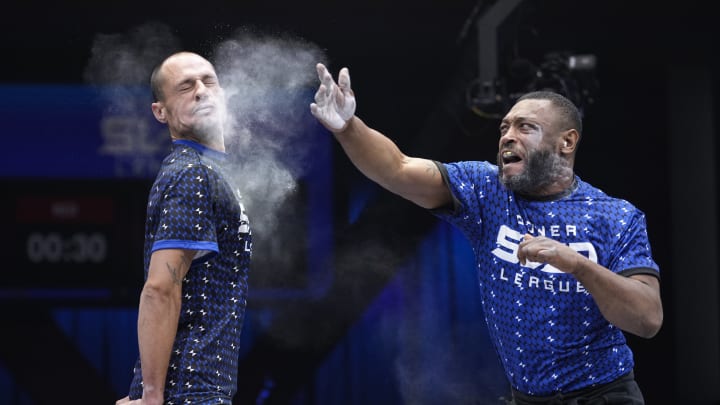Q&A: Power Slap President Defends New Sport Against Early Detractors

Power Slap made its official debut last week on TBS.
UFC staples Dana White, former CEO Lorenzo Fertitta, Executive Vice President and Chief Business Officer Hunter Campbell, and television producer Craig Piligian are attempting to introduce a new sport to the masses in slap fighting. Naturally, there are valid concerns and critiques, particularly surrounding potential long-term health risks for the competitors.
Paving new terrain for the sport is Power Slap president Frank Lamicella. He is overseeing all daily operations—which began with getting the sport regulated—and also includes the growth of the sport and the safety of its fighters.
Speaking with Sports Illustrated, Lamicella addressed some of the loudest criticisms of Power Slap, detailed parallels to the UFC from more than two decades ago, and shared his optimism for the sport.
Sports Illustrated: What were your biggest takeaways from the premiere episode of Power Slap?
Frank Lamicella: We found some potential future stars of Power Slap—slap fighters like Vern “The Mechanic” Cathey, Ryan “King of Kings” Phillips, and Duane “Iron Giant” Crespo—all booked a ticket to the cast house. For many of these slap fighters, episode one represented their first-ever slap match—tune in to the later episodes to see how these guys improve.
We saw significant interest in episode one. Highlights include a successful launch on TBS, trending top 10 on Twitter, eclipsing one million views on Rumble, and accelerating our growth on social media. Since the debut episode, we’ve added over 650,000 followers on TikTok, with Jewel Scott’s knockout victory obtaining over 95 million views on that platform and climbing. Stefon Diggs of the Buffalo Bills also provided some fun organic commentary that went viral.
The commentary on episode one from the Bills’ @StefonDiggs was hilarious 😂 pic.twitter.com/KPcAcrmLnj
— Power Slap (@powerslap) January 22, 2023
SI: The behind-the-scenes footage is interesting, and there is a lot to like about the colorful personalities of the athletes, but there are those–myself included–who are struggling to watch people get slapped across the face so ferociously. Was that discussed internally as a potential problem for the growth of the series and the sport?
Lamicella: It was the opposite. We knew that Power Slap would 'disrupt the disrupted.' Those scrolling through their content feeds pause when they see a Power Slap match. As the season goes on, you will see how much the roster improved—there are three-round battles, incredible comebacks, and more.
SI: There were a plethora of criticisms and complaints surrounding the UFC’s product in 2001. What parallels do you see with Power Slap?
Lamicella: The criticisms of Power Slap are almost identical to those the UFC received in the late 90s and early 2000s. Credit to Lorenzo Fertitta and Dana White on pressing ahead notwithstanding those criticisms—otherwise, we wouldn’t have the UFC that is beloved by fans around the world today.
Like the path the UFC took in its early days, we knew the first step was to get the sport of slap fighting, and the rules of Power Slap, regulated, approved and sanctioned by the Nevada State Athletic Commission. Slap fighting is occurring, so the best thing we could do is to make sure there is a framework in place that protects the health and safety of the athletes competing, and the integrity of the sport.
SI: There has also been plenty of criticism, especially around the health and safety of those involved. What makes you remain confident about Power Slap?
Lamicella: The UFC has had an impeccable track record with athlete health. In our 30-year history, there has not been a serious injury or death in competition. Our competitors take three slaps per match. Compare that to boxing or other combat sports. We believe the “no defense” critique is misguided. While traditional evasion defense may not be used, there are other defensive techniques that our athletes are learning and will only get better at—for example, timing, and precision to roll with a slap but not commit a flinching foul, learning the proper balance of tenseness and strength training to build the head, neck, and upper body muscles.
We spend the money to make sure all health and safety requirements are met for each match. Before a match begins, all participants must pass strict medical testing, including brain scans, physicals and eye exams, including additional comprehensive testing for those 38 years of age or older. Athletes are also subject to drug testing by the commission. During each match, stage catchers are present to help prevent any additional head impact to the mat. There are also multiple physicians, EMS units, ambulances and hospital arrangements in place to ensure that if a participant is injured, they are provided with prompt medical care as soon as possible. After each match, participants are examined by physicians, and if injured, the commission has the authority to mandate medical suspensions.
All Power Slap athletes will be provided the opportunity to be examined by the Lou Ruvo Center for Brain Health in Las Vegas, in partnership with the Cleveland Clinic, which is conducting the largest and longest-lasting brain-health study in professional sports. Athletes are informed about the risks of participating in slap fighting and no athlete is ever forced to fight. The Power Slap rules were also built to limit, reduce potential force. For example, a striker cannot step or pivot when throwing a strike, and must not lead with the heel of the hand. There is a small target area that a strike must land in to be legal—otherwise, risk a clubbing penalty. Penalties for fouls are harsh and include loss of points or the match via disqualification.
SI: Two of the best slap fighters in the world, Darius Mata-Varona and Ron Bata, are serving as the coaches on the show this season. They will compete later this year in a bout on pay-per-view to crown the first-ever Power Slap heavyweight champion.
Lamicella: Darius and Wolverine [Bata] are not only the two best slap fighters in the world but are also two pioneers of the sport. They have fought three times prior, but never on the Power Slap stage. We can’t wait to see them compete for the first-ever Power Slap heavyweight title.
SI: So much of their footage is from underground events. Though their slap fights drew legitimately high numbers on the web, those events exist on dark, grainy film. This is a competition that fits well as an underground sport. Is the major challenge going to be proving otherwise?
Lamicella: We disagree with the notion that this is an “underground sport." It may be a sport in its infancy, but we believe it appeals to the masses.
SI: The competitors have the potential to bring new life to this show. Are there any you think will particularly resonate with viewers?
Lamicella: All of the slap fighters who make it into the cast house are ones to watch. They each have their own unique style and personality.
Michael “Slap Jesus” Smith certainly provides entertainment on stage, but he’s got the skills to back it up. You can also look at someone like Ayjay “Static” Hintz, who has this quiet, stoic confidence, and never rattled. Vern Cathey is someone to watch too—a farmer, mechanic, and highland games participant from a small town in Kansas—who has a devastating slap and precise technique.
SI: Conor McGregor has tweeted a couple times about Power Slap. Are we going to see UFC fighters appear on the show this season?
Lamicella: Conor McGregor, Nate Diaz and even Mike Tyson have all talked about Power Slap. Never say never.
SI: Why should people invest their time in this week’s episode?
Lamicella: Episode two is nonstop action as we look to fill out the cast house. Win the slap-off and you’re in; lose and go home. The group will be introduced to the cast house at the end of the episode, and learn what team they will be on and what coach they will have.
